
After the pandemic, the rise of remote and hybrid work has driven a major shift toward cloud-based IT architectures. In fact, even before the pandemic, the distributed IT management model was already an emerging trend. This is because this model can effectively reduce management and operational costs at various levels, and enables more prompt and flexible responses to events, making it particularly favored by many enterprise organizations adopting hybrid cloud architectures.
Facing a high degree of uncertainty requires a more flexible IT framework
Over the past five years, turbulence in the global political, economic, and health environment has taught us a profound lesson: anything can happen, often unfolding at an unexpected speed. How much advance warning time did local businesses have to evacuate their premises when Russia invaded Ukraine? When health crises escalate into lockdowns, can IT managers still enter server rooms for maintenance? These events have exposed the vulnerabilities and drawbacks of centralized management architectures that put all eggs in one basket. As a result, “risk diversification” has become another core demand of distributed management frameworks.
However, transforming traditional IT deployment models into more advanced architectures has never been a simple task. The technical barriers and software/hardware costs are not low–small and medium-sized enterprises (SMEs) or startups often struggle to afford high IT expenses. Meanwhile, large enterprises aiming to modernize their systems not only face internal political issues but must also commit substantial work hours and resources. This causes many IT personnel and operations teams to hesitate, appearing indecisive on transformation issues.
To give a simple example, try asking your company’s MIS: “If the CMS (Central Management System) server goes down, how do we manage other workstations?” Or “If the submarine cables connecting to headquarters’ server room are accidentally damaged by a fishing vessel or bitten by a shark, will the overseas branch systems become isolated islands?” For most managers still restricted by traditional CMS architectures, their answers probably won’t be very optimistic.
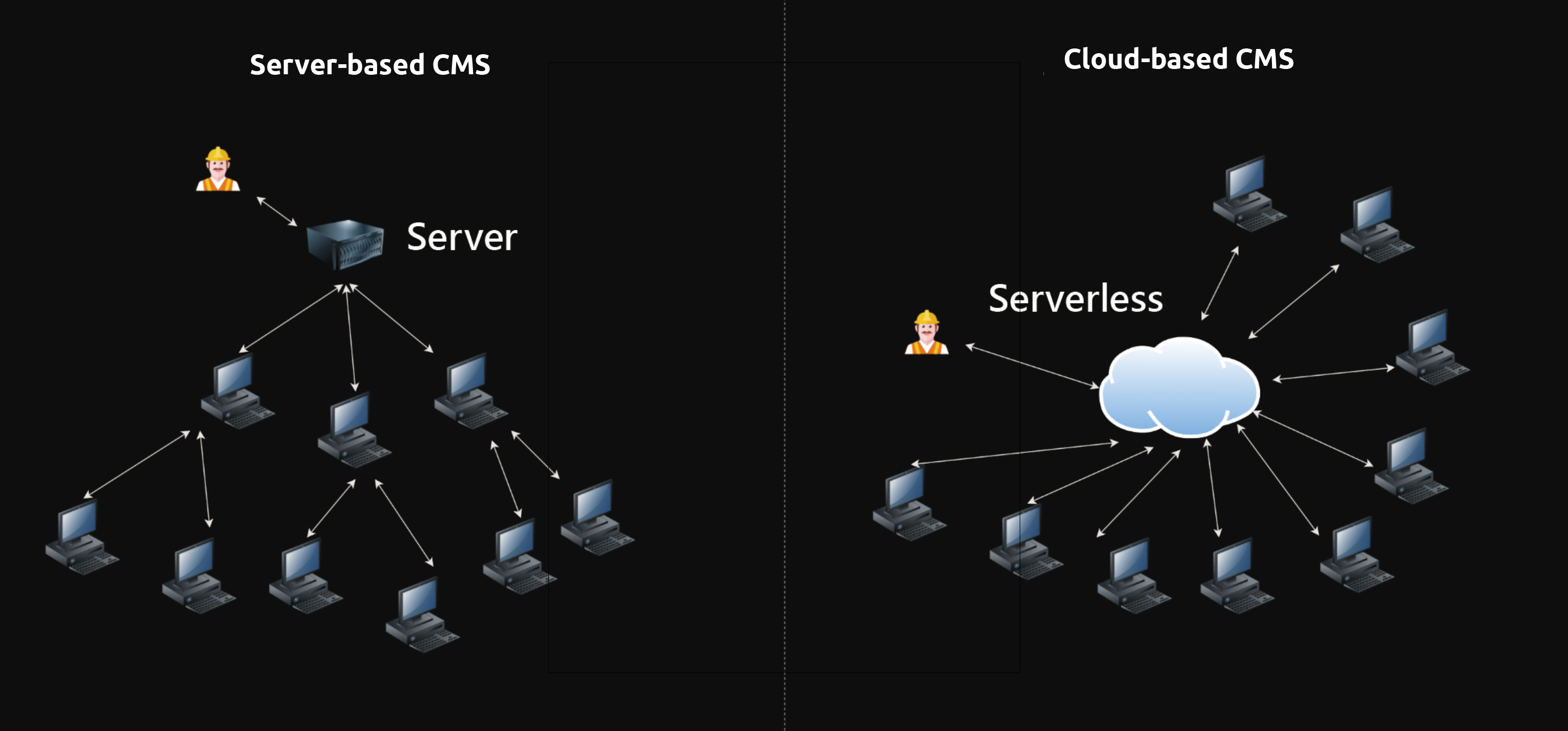 Caption: With traditional CMS, once the server goes down, accessing other nodes at once becomes challenging. Cloud-based CMS solutions do not have this problem.
Caption: With traditional CMS, once the server goes down, accessing other nodes at once becomes challenging. Cloud-based CMS solutions do not have this problem.
AMIZcloud helps simplify IT management tasks
This issue can be significantly improved by implementing QNAP AMIZcloud. AMIZcloud can cloud-enable and decentralize IT device management topology at an extremely low cost, achieving a Serverless architecture while maintaining high reliability and operational flexibility in business operations. Additionally, it can transform the originally closed IT framework into an open, scalable environment, delivering substantial benefits to enterprise IT management.
How does AMIZcloud achieve this? The complete AMIZcloud architecture consists of “Organization Center,” “myQNAPcloud,” and AMIZcloud, each representing different tasks and functions:
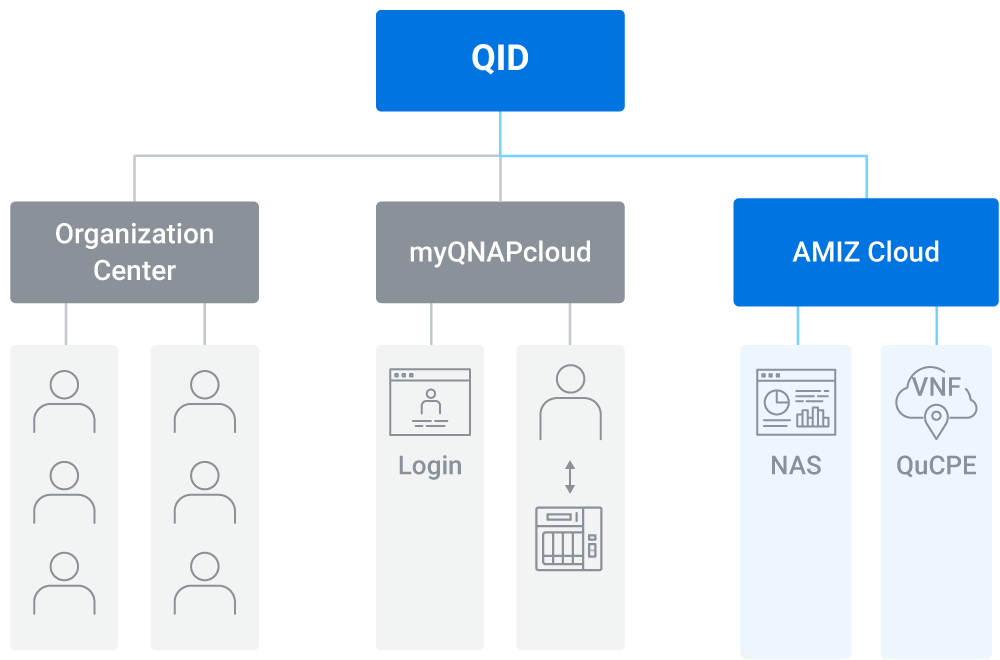
Organization Center
It can be viewed as a “permission collaboration center”. In the past, managing a device and its data typically relied on a single administrator account or a primary administrator group for control. However, department structures within enterprises are often complex, making permission assignments far from simple and straightforward. Organization Center leverages its multi-administrator group and multi-level permission design to flexibly manage multiple devices and support batch equipment deployment, streamlining complex management tasks.
Here’s a simple example: Suppose there are fifty NAS devices in a unit. Traditionally, one or more administrators would need to log in to each device to perform configurations, making the process both time-consuming and labor-intensive. With Organization Center, however, multiple administrators with different permission levels can efficiently manage their assigned NAS devices in batches with just a few clicks on the cloud interface, significantly boosting efficiency.
myQNAPcloud
In practice, myQNAPcloud is an essential tool for remote NAS access. Today, hardly any IT personnel are willing to build complex firewalls or configure tedious NAT rules to achieve remote access. myQNAPcloud streamlines this process, offering what is likely the simplest solution available today.
AMIZcloud
AMIZcloud has the most fundamental difference from myQNAPcloud: its design purpose is not to allow users to directly access data on the NAS, but to help administrators clearly monitor the system status of the NAS. For example, through AMIZcloud, administrators can batch install new firmware, restart or shut down systems, view event logs, and monitor backup progress. In other words, it focuses on “managing devices” rather than “managing data within devices,” making it particularly suitable for large-scale deployments.
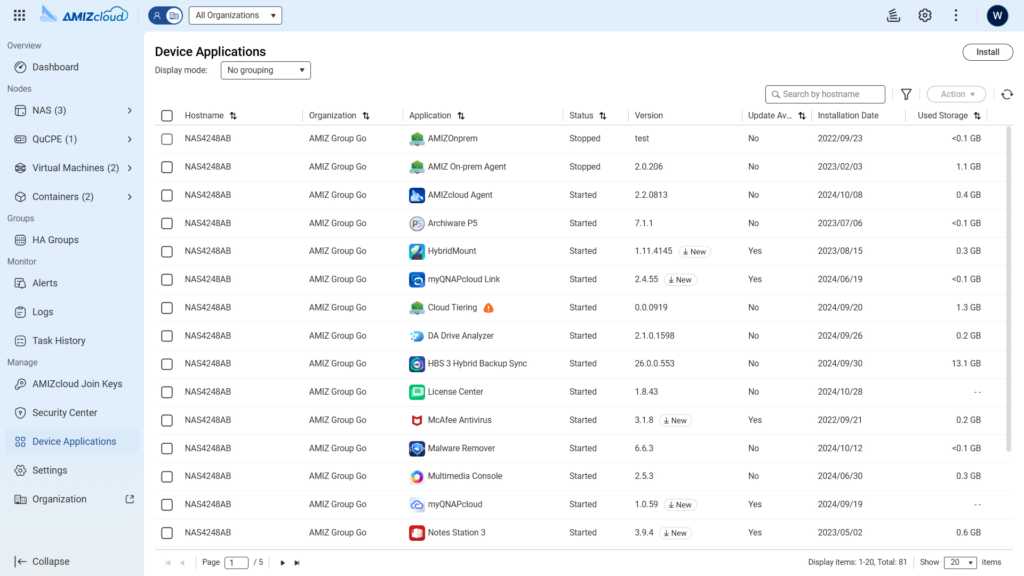
Caption: Remotely installing apps on NAS–this feature allows IT personnel to get a few more hours of sleep.
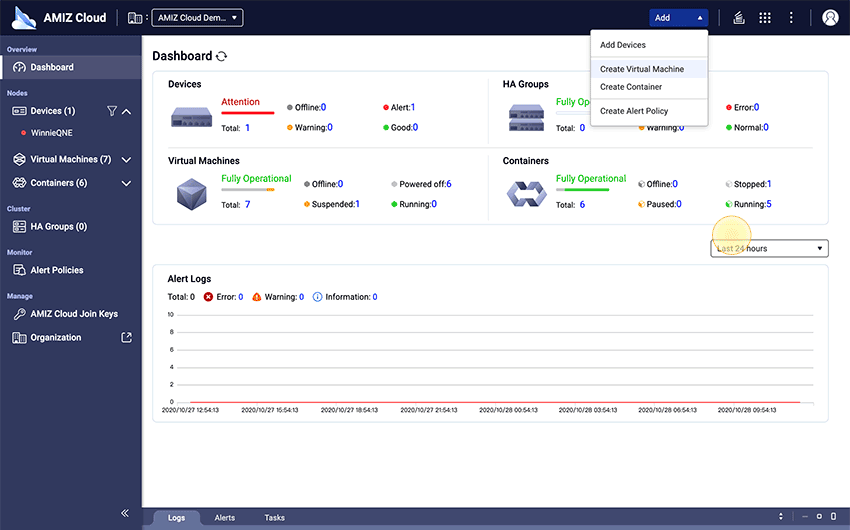
Caption: If a company has already implemented VNF (Virtual Network Function) devices, AMIZcloud can take it to the next level by directly “commanding” these network devices, leveraging the advantages of cloud management.
All of the above can be immediately used by simply applying for a QID. However, everything mentioned above covers the functions of AMIZcloud, so what are its true advantages?
First, AMIZcloud is a fully cloud-based system that requires no additional servers for “hosting”. Devices registered to AMIZcloud within an organization operate independently within the network architecture, without relying on one another. This means that even if one device goes offline or an upstream device fails, it won’t trigger a cascading impact on the entire system. Second, different devices can be assigned responsibilities according to their respective departments. For example, website designers in the marketing department can independently reset or quickly upgrade system versions in test environments as needed, without having to rely on MIS for every task.
An additional advantage of cloud management is more timely and flexible event handling. Issues that previously required administrators to log into servers can now be detected faster with notifications sent out, allowing administrators to resolve issues simply through a web browser.
However, the question arises: despite the numerous advantages of cloud-based distributed management, why hasn’t it become widespread yet? Security protection is a major challenge. If IT personnel attempt to piece together various tools themselves to build a “hodgepodge” management cloud, they often face disasters related to work hours, costs, and maintenance. Just solving issues with the framework itself is already overwhelming, let alone dealing with the demand of device management. However, QNAP has integrated the core advantages of its services into a one-stop solution, directly eliminating these troubles. IT personnel no longer need to worry about technical issues with the cloud system itself, but can focus their energy on managing the equipment and data within the management framework. This is the deeper value of implementing AMIZcloud.
Learn more: Three steps to enable and join AMIZcloud
Am I suitable for implementing AMIZcloud now? How to evaluate?
If it’s a mini personal studio that only needs a few NAS devices to handle ten years’ worth of business volume, then indeed there is no need to “use a sledgehammer to crack a nut” (although AMIZcloud is still very convenient). Making good use of myQNAPcloud is sufficient to significantly improve productivity.
But for growing enterprises, the situation is different. Such enterprises find it difficult to predict when they’ll need to add hardware to accommodate business growth. In a “figuring things out as you go” business model that’s still under observation, flexibility is especially important. At this time, purchasing a one-time CMS service may not be appropriate. For example, if you purchase a CMS license that can manage 5 devices, once the number of devices exceeds this limit someday, you will have to start over. Even if CMS service providers offer more flexible licensing models, enterprises will still be bound by their framework, lacking room for adaptation.
In comparison, managing through AMIZcloud has minimal cost impact regardless of the number of devices. At any time, you can flexibly adjust the total number of managed devices according to business needs. For instance, this month you might receive a large order requiring ten NAS devices to go online simultaneously; next month during the off-season, you can let idle machines rest. Such adjustments won’t increase the cost burden of CMS management at all.
Typical application scenario: convenience stores

Taiwan can be considered a convenience store powerhouse, with almost all locations operating 24 hours a day. You rarely see notices posted at store entrances saying “Temporarily closed for two hours due to system upgrades”. Imagine if chain supermarkets could batch deploy and upgrade equipment through AMIZcloud–promotional campaigns across all locations could be implemented almost simultaneously. Similarly, through simultaneous firmware upgrades, security incidents can be addressed with zero time lag. Accomplishing all this requires just a few mouse clicks on a webpage, with no need for advanced system maintenance skills.
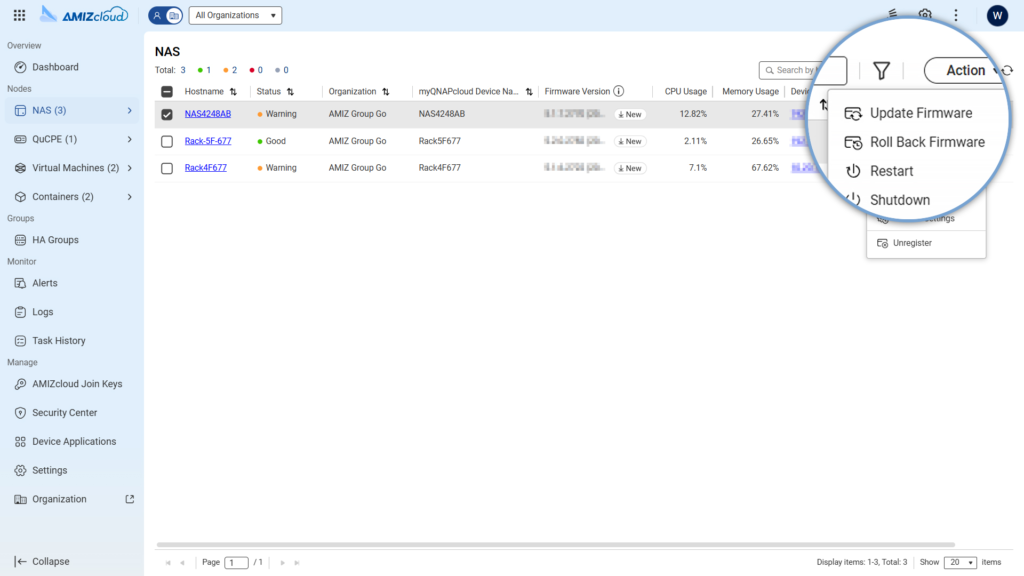
Also Feature: Hybrid Backup Center
When discussing distributed management, it’s hard not to mention offsite backup. For most IT personnel, data backup is no longer as simple as finding a few hard drives of the same capacity to copy data.
Taking the marketing department as an example, each staff member’s computer may need to first back up data to a SAMBA server or NAS, and then the NAS backs up data to the cloud for sharing with external partners or outsourced art personnel. With different permissions and different backup destinations, it’s easy to “make errors” when setting up related backup tasks at each node, and once errors occur, “troubleshooting these errors” can be quite difficult.
Hybrid Backup Center perfectly solves this issue. By setting different backup destinations and data synchronization policies, administrators can easily monitor the backup status of each node. Combined with version control functions, finding specific data no longer requires searching like a needle in a haystack. It can be said that it acts as a “manager of all backup tasks and related services,” and when used in conjunction with AMIZcloud, they complement each other, doubling the effectiveness.
Finally, summarizing the advantages of AMIZcloud:
- Strong scalability: Changes in the number of devices won’t affect CMS management costs, flexibly adapting to business needs.
- High Security: a one-stop solution provided by QNAP, achieving zero-latency cloud security protection.
- Good reliability: Extremely agile response speed for system events, ensuring stable operation.
- Simplifying Complexity: Streamlining management model, greatly reducing time, technical and operational costs.
The key is that you only need one QID to start deploying immediately. Apply now and experience these advantages!